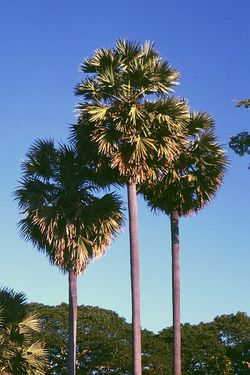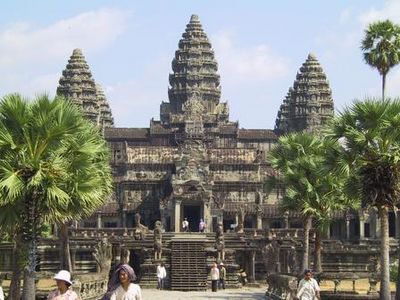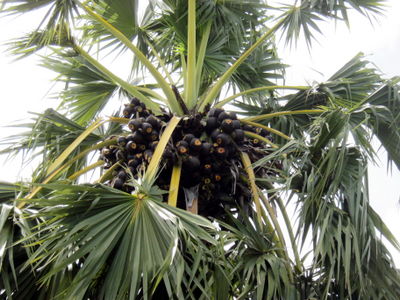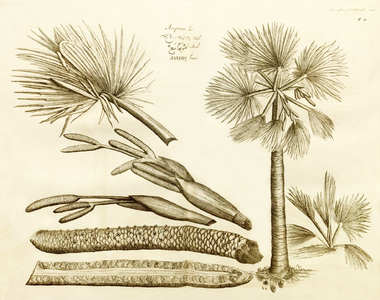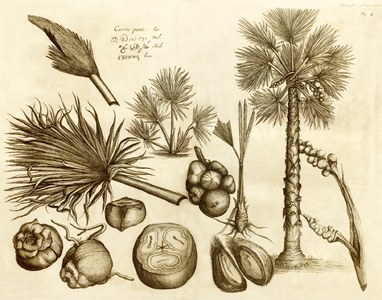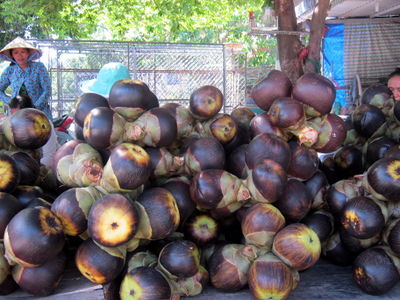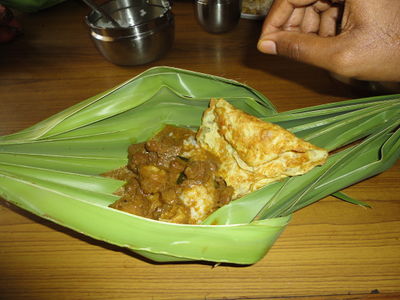Borassus flabellifer
Borassus flabellifer L.
| Order | Arecales |
|---|---|
| Family | Arecaceae |
| Genus | Borassus |
2n = 36
Origin : India
cultivated only
| English | {{{english}}} |
|---|---|
| French | {{{french}}} |
- solitary dioecious palm, 20-25 m high, with black barb
- petiole 60-120 cm, spiny
- leaves palmate, 60-120 cm long
- inflorescence 90-150 cm long, branched
- fruits ovoid, 15-20 cm in diameter, mesocarp fibrous and fleshy
- 3 big black pyrenes
- sap drunk as a beverage, fermented in palm wine and vinegar, distilled in alcohol, or concentrated in sugar
- fruit pulp eaten in desserts or beverage
- gelatinous seed eaten (palm seeds)
- seedling eaten as a starchy vegetable, or in flour
- bud eaten as palm heart
- leaf blades (ola) used as writing base for sacred texts
- leaves used for thatching roofs
- petioles : posts, weaving
- fibre from base of leaves
- wood from stem
- medicinal (all parts)
Description
- English: Palmyra palm
- French: rônier
- Palmyra comes from Portuguese palmeira, "palm tree"
- rônier designates Borassus aethiopum in Wolof
- Hindi tāṛ and Indonesian lontar come from Sanskrit tāla
Popular names
| English | Palmyra palm, brab tree, toddy palm |
| French | rônier, rondier, palmier à sucre |
| German | Palmyra-Palme |
| Dutch | jagerboom |
| Spanish | palmera de Palmira |
| Portuguese | palmeira brava, panuguera |
| Italian | palma di Palmira |
| Hindi | tāṛ, tāḍ; tar-ka-jhar (Wealth of India) |
| Gujerati | tad (Wealth of India) |
| Kannada | taalimara, taatinungumara (Wealth of India) |
| Malayalam | karimpana, nongu (kernel), pana, talam (Wealth of India) |
| Marathi | tad, talat-mad, tamar (Wealth of India) |
| Oriya | talo, tanlo, trinorajo (Wealth of India) |
| Bengali | tal, talgachh (Wealth of India) |
| Tamil | paṇai; karumpanei, nonku (kernel), panai-marom (Wealth of India) |
| Telugu | taadi-chettu, taati-chettu, tooti (Wealth of India) |
| Assam | tal (Wealth of India) |
| Lakher | thiahra (Wealth of India) |
| Lushai | siallu (Wealth of India) |
| Santal | tale (Wealth of India) |
| Burmese | tan bin (PROSEA) |
| Khmer | thnaôt (PROSEA) |
| Lao | ta:n (PROSEA) |
| Thai | tan (general), tan-yai (central), not (southern) (PROSEA) |
| Vietnamese | thốt nốt, thốt lốt. (PROSEA) |
| Indonesia | lontar (general), tal (Java), siwalan (Sumatra), tala (Sulawesi) (PROSEA) |
| Malaysia | lontar, tah, tai (PROSEA) |
Classification
Borassus flabellifer L. (1753)
Forms from Eastern Indonesia are slightly different, and have sometimes be separated under the name Borassus sundaica Becc. (1908).
Cultivars
History
The species originates from India, where it probably appeared as a result of an old introduction of Borassus aethiopum, the African species. The use of leaf blade rectangles (ola) as a support for writing goes up to Pannini, the grammarian who allegedly coined the Sanskrit alphabet ca. 400 BC. The Pali Buddhist canon dating 5th century BC. was also written on olas. What is ignored is whether the palm was Borassus flabellifer or a Corypha. Anyway, its use is very old in Southern India and Ceylon.
The fame of the Palmyra palm had reached the ancient Greeks, and Megasthene (320 BC., quoted by Arrian) cites the tala, confusing it with the coconut.
Diffusion of the Palmyra palm from southern India followed that of buddhism in Burma, Thailand, Cambodia (Angkor) and Vietnam. This palm was planted near temples, and its leaves were used for writing sacred texts. To the south, Palmyra palm followed the routes of Indian trade, to Java and Eastern Indonesia. In contrast, it seems to be absent from the regions of Chinese culture.
Uses
- നൊങ്ങ് സര്ബത്ത്൨.JPG
palm sap sherbet in Tamilnadu
- Sap. It is extracted from inflorescences. Female trees and inflorescences give more yield, but male trees are used when fruits from female trees are harvested. Inflorescences are tied and beaten, before being incised. Two liters are obtained daily, the incision being refreshed daily. In its life, a tree can give 120 000 l sap.
- The fresh sap contains 12% saccharose, and is appreciated locally as a beverage, sometimes mixed with sugar cane juice and coconut water.The name of this beverage is sweet toddy, neera or nīrā (Hindi, Gujerati, Marathi), taler rash (Bengali), henda (Kannada), panamkallu (Malayalam), padaneer (Tamil), teepikallu (Telugu).
- Production of jaggery, a deep brown sugar, is the most important use in India. This word has the same origin as sugar, but came to Anglo-Indian through Malayalam chakkara and Portuguese jagara. This sugar is obtained by boiling the sap. In Indonesia, it is moulded in half-spheres, packed two at a time in the dried leaves of the same palm. The jaggery is called tadgud (Hindi), taler gur (Bengali), panamchakkara (Malayalam) or taatibellamu (Telugu).
- By fermenting the sap, a palm wine is obtained, called tāṛī, "product of tāṛ" in Hindi, which gave Portuguese tari and Anglo-Indian toddy. It is one of the most popular alcoholic beverages in South Asia. The true toddy comes from Borassus flabellifer, but the name is often used as a generic name for all palm wines, be they from Cocos nucifera, Caryota urens, Nypa fruticans, Phoenix silvestris or even Phoenix dactylifera.
- With toddy, a vinegar can be processed or, through distillation, an arrack.
- Fruits have several uses. The pulp is eaten in desserts. Once crushed, it gives a beverage.
- The seed almond of the young fruit has a gelatinous consistency and a white opalescent colour. It is traded in tins under the name palm seeds (dhavanai in Tamil).
- Seedlings have a form of elongated cone 30 cm long, and contain a white crispy flesh. They are harvested when they give their first leaf, an eaten locally as a vegetable (Telugu : tīgalu or panai kizhangu; Singhalese : kelengu).
- From the boiled and dried seedling, a flour is extracted, called oṭiyaḷ in Tamil (often written odial).
- The apical bud gives a palm heart.
- Leaves have long been used as a support for writing. The size of pages (or ola) is determined by the blade broadth between two veins, and pages are tied together by strings, in such a way that the "book" opens in accordion. Leaves are also used to thatch roofs, or to plait many kinds of artifacts.
- Petioles are used entire as posts, or split as material of basketry.
- The base of leaves gives an appreciated fiber, exported by India.
- All tree parts are used in pharmacopeia.
References
- Davis, T.A. & Johnson, D.V., 1987. Current utilization and further development of the palmyra palm (Borassus flabellifer L., Arecaceae) in Tamil Nadu State, India. Economic Botany, 41: 247-266.
- Dransfield, J., 1976. Palm sugar in East Madura. Principes, 20: 83-90.
- Ferguson, William, 1850. The Palmyra Palm. Borassus Flabelliformis: A popular description of the palm and its products, having special reference to Ceylon : with a valuable appendix embracing extracts from nearly every author that has noticed the tree. Colombo, Observer Press. 91 p. on line at GoogleBooks
- Fox, J.J., 1977. Harvest of the palm. Harvard University Press, Cambridge, Massachusets, United States. 290 pp.
- Kovoor, A., 1983. The palmyrah palm: potential and perspectives. FAO Plant Production and Protection Paper, 52. Food and Agriculture Organization, Rome, Italy. 77 pp.
- Lubeigt, G., 1977. Le palmier à sucre, Borassus flabellifer L., ses différents produits et la technologie associée en Birmanie [The sugar palm, Borassus flabellifer L., its different products and associated technology in Burma]. Journal d'Agriculture Traditionelle et de Botanique Appliquée, 24(4): 311-345.
- Lubeigt G., 1982. Une civilisation du palmier à sucre en Asie. Le Courrier du CNRS, 44 : 24-35.
- Morton, J.F., 1988. Notes on distribution, propagation, and products of Borassus palms (Arecaceae). Economic Botany, 42(3): 420-441.
- PROSEA 9, 1996. Plant resources of South-East Asia. vol. 9. Plants yielding non-seed carbohydrates. ed. by M. Flach & F. Rumawas. Leiden/Wageningen, Backhuys/PROSEA. (Bogor, PROSEA, 1996). pp. 59-63.
- Purseglove J.W., 1972. Tropical crops: Monocotyledons. Harlow (U.K.), Longman. X-607 p.
- Romera, J.P., 1968. Le Borassus et le sucre de palme au Cambodge [Borassus and palm sugar in Cambodia]. L'Agronomie Tropicale, 23: 801-843.
- Wealth of India (The), 1988. A dictionary of Indian raw materials and industrial products. New-Delhi, Council of scientific and industrial research. Vol. 2 : B. XLII-350+90 p. Revised edition. pp. 187-198.
